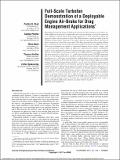Full-Scale Turbofan Demonstration of a Deployable Engine Air-Brake for Drag Management Applications
Author(s)
Pfeiffer, Gordon; Davis, Rory; Hartley, Thomas; Shah, Parthiv N.; Spakovszky, Zoltan S
Downloadgtp_139_11_111202.pdf (7.686Mb)
PUBLISHER_POLICY
Publisher Policy
Article is made available in accordance with the publisher's policy and may be subject to US copyright law. Please refer to the publisher's site for terms of use.
Terms of use
Metadata
Show full item recordAbstract
This paper presents the design and full-scale ground-test demonstration of an engine airbrake (EAB) nozzle that uses a deployable swirl vane mechanism to switch the operation of a turbofan's exhaust stream from thrust generation to drag generation during the approach and/or descent phase of flight. The EAB generates a swirling outflow from the turbofan exhaust nozzle, allowing an aircraft to generate equivalent drag in the form of thrust reduction at a fixed fan rotor speed. The drag generated by the swirling exhaust flow is sustained by the strong radial pressure gradient created by the EAB swirl vanes. Such drag-on-demand is an enabler to operational benefits such as slower, steeper, and/ or aeroacoustically cleaner flight on approach, addressing the aviation community's need for active and passive control of aeroacoustic noise sources and access to confined airports. Using NASA's technology readiness level (TRL) definitions, the EAB technology has been matured to a level of six, i.e., a fully functional prototype. The TRL-maturation effort involved design, fabrication, assembly, and ground-testing of the EAB's deployable mechanism on a full-scale, mixed-exhaust, medium-bypass-ratio business jet engine (Williams International FJ44-4A) operating at the upper end of typical approach throttle settings. The final prototype design satisfied a set of critical technology demonstration requirements that included (1) aerodynamic equivalent drag production equal to 15% of nominal thrust in a high-powered approach throttle setting (called dirty approach), (2) excess nozzle flow capacity and fuel burn reduction in the fully deployed configuration, (3) acceptable engine operability during dynamic deployment and stowing, (4) deployment time of 3-5 s, (5) stowing time under 0.5 s, and (6) packaging of the mechanism within a notional engine cowl. For a typical twin-jet aircraft application, a constantspeed, steep approach analysis suggests that the EAB drag could be used without additional external airframe drag to increase the conventional glideslope from 3 deg to 4.3 deg, with about 3 dB noise reduction at a fixed observer location.
Date issued
2017-08Department
Massachusetts Institute of Technology. Department of Aeronautics and Astronautics; Massachusetts Institute of Technology. Department of Mechanical EngineeringJournal
Journal of Engineering for Gas Turbines and Power
Publisher
ASME International
Citation
Shah, Parthiv N., Gordon Pfeiffer, Rory Davis, Thomas Hartley, and Zoltán Spakovszky. “Full-Scale Turbofan Demonstration of a Deployable Engine Air-Brake for Drag Management Applications 1.” Journal of Engineering for Gas Turbines and Power 139, no. 11 (August 1, 2017): 111202.
Version: Final published version
ISSN
0742-4795